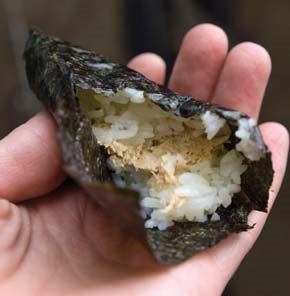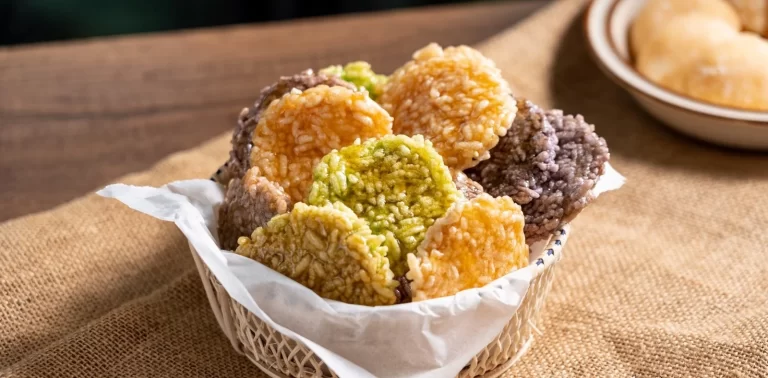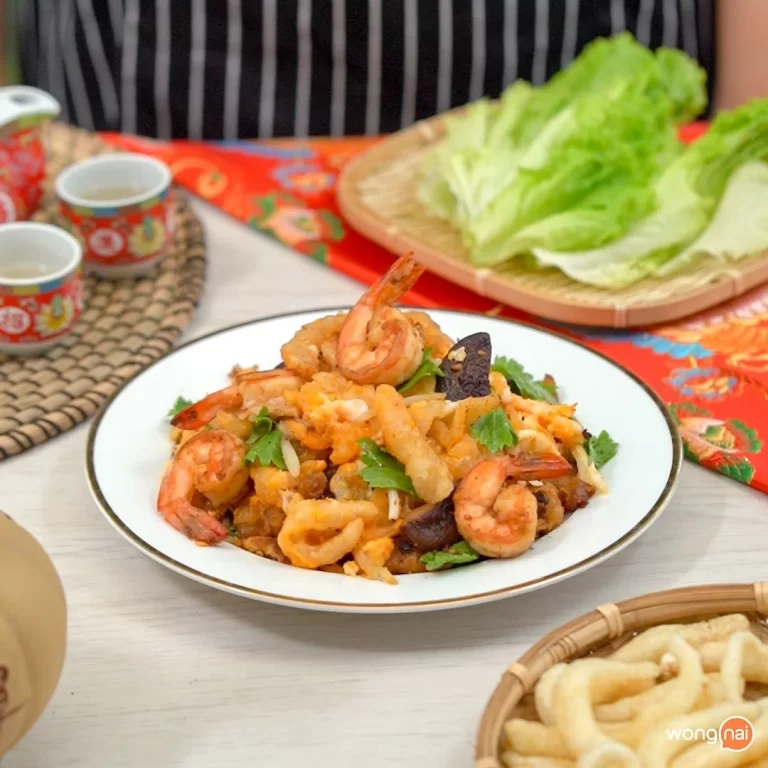WHEN I ASKED KEIKO NAKA, the proprietor of Ton-Ton Japanese Food Cart, the origins of this dish, she shrug-ged and smiled and told me, “This is what we would take to a picnic.” In Tokyo, where these triangles of rice are street food staples, onigiri are sold in a wide variety of flavors, from preserved plum to salmon. A typical convenience store might stock twenty or more flavors. Keiko stocks nine. Tuna is her most popular.

MAKES 8 ONIGIRI
1 can (5 ounces) solid white tuna, drained and flaked with a fork
2 tablespoons mayonnaise
1 teaspoon soy sauce
½ teaspoon chili powder
4 cups warm cooked sushi rice
8 sheets of nori, cut in 2-inch wide strips (see Note)
- Place the tuna, mayonnaise, soy sauce, and chili powder in a small bowl and stir to mix. Set the mixture aside.
- Moisten your hands with cold water. Take ½ cup of the rice and place it in one hand. Make an indention in the middle of the rice with your thumb. Put about 1 tablespoon of the tuna mixture in the indention. Encase the tuna filling in the rice, first forming it into a ball, then working it into a triangular shape. Repeat with the remaining rice and tuna filling.
- Wrap each triangle of rice in 1 or 2 strips of nori. Moisten with water to seal. Serve the onigiri immediately or wrap them tightly in plastic wrap and refrigerate.
NEW ORLEANS STREET NOODLES:
Meet Old SoberNEW ORLEANS BOASTS a long tradition of street commerce. In Creole Sketches, Lafcadio Hearn documented the comings and goings, as well as the appearance and demeanor, of New Orleans food peddlers of the late 1800s. Most were women of African extraction. They sold pralines. They sold fish and vegetables. And, most famously, they sold calas, fried rice fritters.
“The Cala woman was a daily figure on the streets till within the last two or three years,” wrote the editors of the 1901 edition of The Picayune Creole Cook Book. “She went her rounds in bandana tignon, guinea blue dress, and white apron, and carried on her head a covered bowl in which were the dainty and hot Calas. Her cry, ‘Belle Cala! Tout Chaud!’ would penetrate
the morning air, and the olden Creole cooks would rush to the doors to get the first fresh, hot Calas.”
Today New Orleans street food is still a driver of the culinary economy. A few mobile enterprises, like the Lucky Dogs carts and the Roman Candy Man wagon, remain in place as tradition bearers. Freelance praline sellers still walk the French Quarter, while unlicensed catering trucks do drive-bys of local colleges and high schools, selling crab patties and shrimp pies.
Taco trucks arrived in the wake of the levee failures that followed Hurricane Katrina. In the post-Katrina economy, those taco trucks did most of their business in sight of construction sites. More recently they’ve moved to the margins of the city or, in some cases, begat brick-and-mortar taquerias. Many of the traditional vendors, on the other hand, have begun focusing more intently on carnivals and festivals. The second line parades associated with Mardi Gras Indian celebrations are especially important.
Working from a cherry-red concession trailer, Danielle Brown sells Sno-Balls drenched in bubble gum and red velvet cake flavorings. On occasion, she parks near the intersection of Claiborne Avenue and Robertson Street. But she does most of her business at second line parades. “I’ll park at one end of the parade,” she told me. “And my husband will park at the other. And we’ll be steady making Sno-Balls.”
Also working the second line circuit is Linda Green. She sells paper cups of frozen Kool-Aid, concoctions she calls hucklebucks, and foam cups of
ya-ka-mein, a kind of low-rent riff on pho that many drinkers call “old sober.” (The reference, Linda says, is to the sobering qualities of hot noodle soup.)
Although Linda likes the second line crowds best, she also works the New Orleans Jazz & Heritage Festival each spring. Eats served at Jazz Fest are not in the strictest definition of the word street food, but they certainly reflect the democratic ideals that inform the best street foods.


